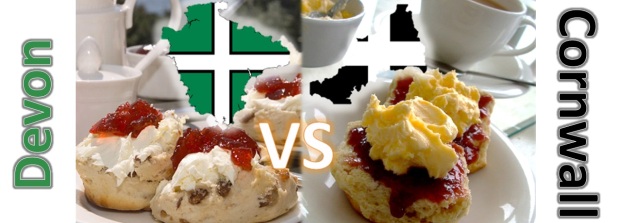 Devon and Cornwall have debated which county serves its cream teas the better way for years; both passionately believing that their cream teas are best with the argument also extending to whose clotted cream tastes the nicest. Even most non-residents of the counties have an opinion on whether jam or cream should be served on top. A number of scientists have entered into the debate in an attempt to use scientific evidence to settle the agreement.
Devon and Cornwall have debated which county serves its cream teas the better way for years; both passionately believing that their cream teas are best with the argument also extending to whose clotted cream tastes the nicest. Even most non-residents of the counties have an opinion on whether jam or cream should be served on top. A number of scientists have entered into the debate in an attempt to use scientific evidence to settle the agreement.
About Devonshire cream teas and how they’re served:
Devonshire Cream Teas, where a pot of tea is accompanied with scones, jam and clotted cream are served in Devon with cream on the bottom and jam on top. The county has eaten them this way ever since the cream tea’s origin in Tavistock Abbey, Devon, where the tradition of eating bread with cream and jam began in the 11th century (disputed by the Cornish). As well as it being tradition, Devonians also argue that the cream is like butter and you wouldn’t put butter on jam, they also believe that it’s possible to load more clotted cream on if you apply it first.
The difference between Cornish cream teas vs Devon
Historically, there have been lots of variations between Cornish and Devon Cream Teas such as the type of scones and clotted cream used but nowadays the main difference is just how they’re served. The Cornish opt to serve cream teas with jam on the bottom and cream on top, arguing that you can taste the cream better on top and it’s easier to spread this way.
What the experts say
One scientist, Dr Farrimond, has produced research showing the optimal ratio of scone, cream and jam is 4:3:3 meaning that a 40g scone should be served with 30g of cream and 30g of jam. This achieves what he said was the hedonic breakpoint, the optimal sweetness for appreciating the flavours, meaning that the richness of the cream dilutes the sweetness of the jam. This ratio led Dr Farrimond to believe the Devon way of serving jam on top is the better option because even on a warm scone, the jam is not viscous enough to support easy spreading of the cream on top. He even assembled a tasting panel for his research with 57% expressing a preference for the Devon-style method.
Another scientist, Dr Cheng, came up with a daunting equation that took into consideration the radius of scone and even depth of the dollop of topping. He supported the Cornish style cream tea, concluding that the jam, “due to its density”, needs to be spread prior to the application of the clotted cream, as the opposite approach may cause the jam to run off.
I didn’t know there was so much science involved! I’m going to both Devon and Cornwall soon so will be sure to try both!!
LikeLike
Common sense will dictate here.Putting cream on a warm scone first enables it to sink into the scone making the scone taste better.then applying a good conserve (not Jam) gives the perfect set up
LikeLike